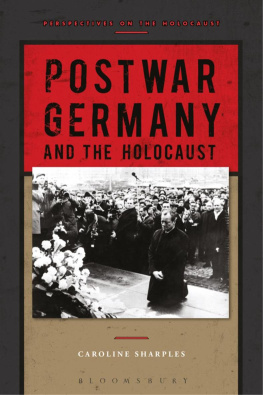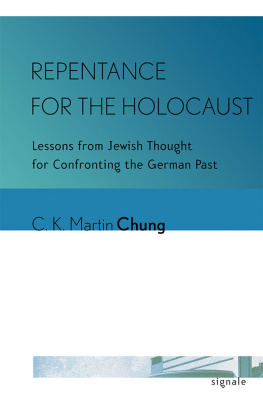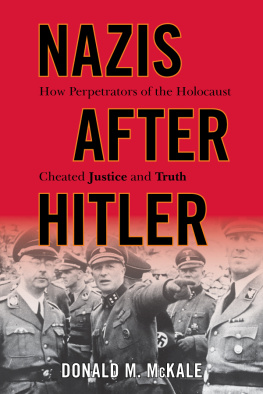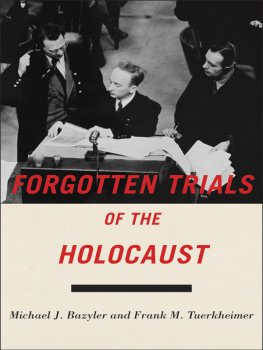Introduction
In the last few years, three issues have been at the forefront of historical scholarship on modern Germany, and especially the Third Reich. First, the study of the Holocaust and other aspects of Nazi Germanys policies of mass murder has expanded enormously. Second, the relationship between the German military and the regimes policies of occupation, subjugation, ethnic cleansing, and genocide has received increasing attention. And third, a growing volume of literature has focused on the impact of World War II and genocide on the formation of postwar identity and the politics of memory, especially in Germany, but also in many other European countries, the United States, and Israel.
Several events can serve to illustrate the new focus in research and writing on, as well as public interest in, the criminal nature of Germanys war between 1939 and 1945, the genocidal policies pursued by the Nazi regime, and the links between the two. One prominent example is the publication of and subsequent debate on Daniel Jonah Goldhagens book, Hitlers Willing Executioners . Based on the study of several reserve police units involved in the murder of thousands of Jews, an examination of a number of Nazi labor camps, and a reconstruction of some of the death marches during the last months of the war, the book argues that the Holocaust was the direct outcome of a uniquely German type of exterminationist antisemitism. Goldhagen insists on erasing the distinction between Nazis and Germans and asserts that by the time of the Third Reich, following a long process of an evolving culture of antisemitism, the vast majority of Germans would have been glad to participate in, and certainly supported, the elimination of the Jews of Europe.
This book unleashed a major scholarly and public debate in the United States and Britain and, even before its appearance in a German translation, dominated the academic and media scene in Germany for many months. Obviously, Goldhagens thesis came very close to leveling a charge of collective guilt at the German people during the Hitler dictatorship, an argument that had been rejected by the majority of Germans and most foreign scholars for many years. At the same time, the book insisted on the centrality of antisemitism to the genocidal policies of the regime. This assertion refocused the debate on the nature of Nazism, which for the previous couple of decades had veered away from ideology and prejudice and insisted on structural factors as the main causes of Nazi policy. Finally, the book insisted on observing the individual perpetrators (and, to a somewhat lesser extent, individual victims), and thereby reversed a trend that emphasized the bureaucratic and mechanical aspects of the killing process and greatly underplayed the individual identity and motivation of the killers.
The second and more or less simultaneous event had to do with the publication of the diaries of the philologist Victor Klemperer, a converted Jew married to an Aryan woman who spent the entire period of the Nazi dictatorship in Dresden, writing a highly detailed and perceptive account of these years in his diary. This massive two-volume work competed with Goldhagens book as one of the sensational best sellers of the 1990s in Germany. In some ways, Klemperers diary presented precisely the opposite view, since it demonstrated both the stubborn patriotism of a man who was being persecuted by the regime for what it perceived as his alien nature, and at the same time provided numerous examples of German individuals who expressed sympathy for their Jewish neighbors and at times even came to their help. In another sense, however, Klemperers diary offered the German public a new view of the reality of the Third Reich, since it was written by a highly articulate member of the German academic elite who simultaneously had been pushed to the margins of society and reported on its progressive deformation from within the belly of the beast. Rather than being either an account by an insiderwhich would have normally contained a great deal of conscious and unconscious apologeticsor by an outsiderwho could not be expected to provide much insight into German societythis was an extraordinarily acute analysis of the day-to-day workings of German life under Hitler by the epitome of the insider transformed into the paradigmatic outsider.
Thus Klemperers book refocused scholarly and public attention on the plight of German Jewry and the process whereby a small but significant segment of German society had been marginalized, ostracized, deported, and finally murdered in full view of their German co-citizens. Precisely Klemperers patriotism and insistence on his Germanness compelled readers of this text to ponder how those who had contributed so much to German culture could have been stripped of their identity and handed over to the killers. In other words, Klemperer made the victim into a recognizable fellow German and thereby erased the barrier that had kept the victims of the regime more conveniently as alien foreigners and Jews.
The third event that marked the changing focus of scholarly research and public interest was the exhibition War of Extermination: Crimes of the Wehrmacht, 19411944, which toured Germany and Austria throughout the second part of the 1990s and was viewed by close to a million visitors. What made this exhibition into a major event was both the exhibit itself, which contained many hundreds of photographs, mostly taken by the perpetrators, of atrocities committed or facilitated by regular army soldiers, and the public debate that was unleashed repeatedly thanks to the fact that the exhibition moved from one town to the next. What many Germans found hard to take was that the exhibition demonstrated in the most graphic manner the complicity of Wehrmacht soldiers in the Holocaust and other crimes of the regime, especially in the occupied parts of the Soviet Union and Yugoslavia.
The army had long managed to protect itself from the charges of complicity with the Nazi regime that had been leveled at other agencies of the dictatorship. Although scholarship had begun exposing military involvement in Nazi policies as early as the 1960s, and with increasing momentum since the 1980s, the public at large often either did not know about these specialized studies or preferred to ignore their implications. The most obvious ramification of such revelations wasnot unlike the somewhat less well documented charges made by Goldhagenthat the majority of Germans knew about the mass killing perpetrated by the regime and that large numbers of them actually took part in or directly facilitated the implementation of genocidal policies. Close to 20 million soldiers passed through the ranks of the Wehrmacht, that is, a vast proportion of men of military age out of a total population of some 80 million. These men either participated in numerous massacres or witnessed them at close quarters, and many of them are known to have reported such events, whether with fascination, glee, or horror, to their families in the rear. The implication of this was not only that Germans knew much more than they wanted to concede after the war, but that the young men who rebuilt both Germanys had shortly before been closely associated with genocide during their long years of service in uniform.
The exhibition was closed in November 1999 due to growing public pressure following the revelation that someand as it turned out, very fewphotographs had been mislabeled by the organizers. In particular, what helped the critics of the exhibition was that some photos were in fact not of the victims of the Wehrmacht but of men and women murdered by the NKVD, the Soviet secret police. This was quickly linked by some conservative critics to the more general assertion that rather than being a criminal organization, the Wehrmacht had merely reacted to and striven to protect Germany from the crimes of the Red Army and other Soviet agencies. This kind of logic had already been employed by German propaganda during World War II, arguing that it was necessary to invade and destroy the Soviet Union because otherwise the USSR would do the same to the German Reich.









